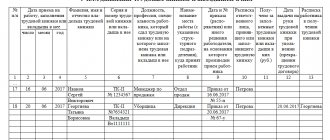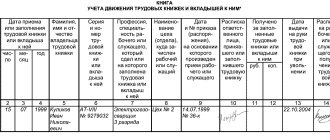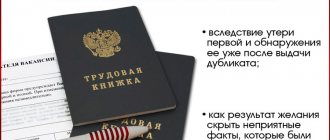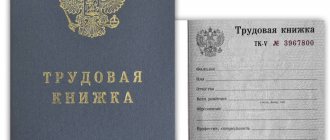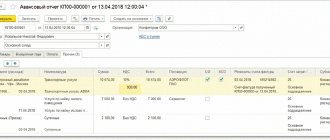The work book has been valid in Russia since 1939. At the same time, its form has been changed several times and currently the work book of the 2004 model is used, the form of which is approved by the Government of the Russian Federation. Since work record forms are equivalent to strict reporting forms, they must be accounted for and stored accordingly. Similar requirements are established for storing employee work records. In the article, we will remind you how to ensure proper accounting and storage of work records in an organization and what documents to prepare in this regard.
Order
The procedure for maintaining and storing work books falls on the responsible persons. The work book is the responsibility of the employer, who is obliged to keep work books for employees who have worked in the organization for more than five days, if the work in this organization is the main one for the employee.
After registering the employee in the relevant position, the employer fills out the Labor Code, entering into it the basic information:
date of hire;- job title;
- name of company;
- corresponding order.
This tradition of conducting labor records developed at the dawn of the formation of the Soviet state, without losing its relevance to this day.
Work books are kept for all employees working in the institution, if the work is official.
The adopted Labor Code of the Russian Federation carried out the transition of the right to use Soviet documents in the new conditions of statehood, gradually and step by step modernizing the registration of workers and their migration within the Russian Federation.
Legal policy in the field of labor is aimed at the most painless adaptation of outdated traditions to new conditions and requirements.
Currently, workers of three generations coexist in one segment of labor history. This is marked by the presence of a single regulatory space, which takes into account the following types of labor codes:
- 2004 release;
- 1973 release;
- 1938 release.
At the same time, the documents are unified regardless of the source of origin, which may rightfully be another state that was previously part of the Union as a union republic.
According to existing standards, entries made in information about work before the collapse of the union and the introduction of the Labor Code of the Russian Federation are relevant both for determining the qualifications of an employee and his professional experience, and for taking into account work experience.
Results
Accounting for work records is a mandatory procedure for organizations. The choice of accounts for its management is a very controversial issue and is interpreted ambiguously by officials. We propose to use a scheme in which work books are accepted for accounting as BSO.
Sources
- https://online-buhuchet.ru/buxgalterskij-uchet-trudovyx-knizhek/
- https://online-buhuchet.ru/uchet-trudovyx-knizhek-v-buxgalterskom-uchete-provodki/
- https://clubtk.ru/forms/trudovyye-knizhki/kniga-ucheta
- https://nalog-nalog.ru/buhgalterskij_uchet/vedenie_buhgalterskogo_ucheta/nuzhen_li_buhgalterskij_uchet_trudovyh_knizhek/
- https://nalog-spravka.ru/buxgalterskij-uchet-trudovyx-knizhek.html
- https://www.klerk.ru/buh/articles/473462/
- https://www.Delo-Press.ru/articles.php?n=14438
- https://buhguru.com/buhuchet/realizatsiya-trudovyh-knizhek-sotrudnikam-provodki.html
Responsible persons
Work books in an organization (enterprise) are maintained by a special department responsible for personnel work or an authorized person.
Large enterprises must have a personnel department . Several specialists in charge of personnel records are divided into areas of responsibility.
In particular:
- in sectors of nomenclature office work, where a specialist is responsible for conducting certain operations;
- by departments assigned to the responsible specialist.
In medium and small organizations with less than 100 employees , such a department may not exist. The execution of work is delegated to one of the administrative or other authorized employees:
- upon release from other types of work;
- without one.
Organizations with fewer than 30 employees may not have an exempt HR specialist. Usually, work with labor records is assigned to the secretary and clerk, and in his absence, the head of the organization assumes responsibility. Often, personnel work is carried out by accounting employees.
Accounting for cash receipts
Enterprises must receive compensation for the cost of the document - the amount spent on its acquisition. The amount of the fee should not exceed the purchase price (excluding VAT). The possibility of receiving payment is provided for in clause 47 of the Rules. Despite the fact that the presentation of the work book is the responsibility of the company, the amount deposited by the employee into the cash register of the enterprise can be considered as revenue, the receipt of which requires the use of cash register equipment.
To avoid controversial issues with the tax office, the best option is to withhold the amount when calculating the employee’s wages. Withholding is carried out at the request of a person sent to the manager or chief accountant.
No deduction is made without the employee's consent: (click to expand)
| Purpose of the operation | Account debit | Account credit |
| Receipt of payment for the provided form at the cash desk is reflected | 50 | 73/3 |
| Deduction of the cost of the form from the payslip is reflected | 70 | 73/3 |
| Income from the fee received is reflected | 73/3 | 91/1 |
If an employee refuses to pay the amount spent by the employer on the purchase of a work book, the cost is written off from the company’s funds. The amount is reflected in other expenses of the enterprise.
Proper storage procedure
The main rule of storage is the procedure for monitoring the safety of personnel documents.
Work books, according to the general provision established by the Labor Code in Article 66, must be kept by the employer throughout the person’s working life. On the day of dismissal, the employer or person in charge hands it over, against signature.
It is issued to an employee accepted under the main employment contract no later than 5 working days, guided by part 4 of article 66 of the Labor Code of the Russian Federation .
Filling out the Labor Code is carried out based on the legal basis of the Labor Code, using standard filling wording, in accordance with the established regulations. The entries must be in perfect appearance and made without blots or corrections.
After filling out the information about hiring, the documents are registered in the corresponding accounting journals. After registration, the documentation is placed in the designated areas.
Organization of storage space
Where should workers' work books be kept and how should work books be stored?
The conditions for storing work books are regulated by Decree of the Government of the Russian Federation of April 16, 2003 N 225 “On work books” .
It determines that this document belongs to the status of documentation subject to the strictest accounting and control. For this reason, the storage location must be provided with appropriate maximum protection .
Almost every employer understands that the absence of direct instructions does not negate the reinsurance of storing work records in a safe or fireproof cabinet of special strength . In emergency situations, a report on the security measures taken will be required from him.
Storing these documents on open shelves in places of easy access is unacceptable. This information is considered personal data, and its loss is fraught with complex legal consequences.
Places for storing TC forms
Newly arrived employees are provided with a work book after being hired. It is started directly at the enterprise, on a new, clean, previously unused form.
The Labor Code form is the basis of an employee’s book, which, however, does not have the same value. Accordingly, its storage is not associated with certain conditions.
Where are blank work record forms stored? Forms can be stored in a place provided by a personnel officer or directly by the manager.
If the forms are damaged, the organization will suffer minor material damage, limited to the purchase of new copies.
However, a conscientious employee is obliged to keep them clean and not leave them in an accessible place, trying to limit them from theft.
Improper storage of forms can provoke criminal intent among morally unreliable persons. Although in many regions TC forms are freely available.
Damaged forms are written off by a special act and destroyed.
Who purchases a work book form
Personal personnel papers are strictly accountable documents and are purchased by employers. The procedure for providing employers with these forms is established by Order of the Ministry of Finance No. 117n dated December 22, 2003. It says that the only organization that has the right to produce forms is the GOZNAK association of the Ministry of Finance of the Russian Federation. Only specialized distributors approved by GOZNAK have the right to supply forms to users.
If a citizen does not have a work permit, the employer provides him with a blank form; if it is completely filled out, an insert form.
The costs of the forms are included in the company's expenses: Debit 20, 26, 44 Credit 60. Cost of the document provided to the employee:
- is compensated by depositing the appropriate amount into the organization’s cash desk;
- deducted from the employee's salary.
Maintenance process
How to keep a work book? The work record book becomes the object of activity of personnel specialists after hiring an employee for permanent work and concluding an employment contract with him.
Since the acceptance of a person to a position is carried out by order, the corresponding order will play an important role in working with this document.
In general, the management process is based on the provisions of Article 66 of the Labor Code of the Russian Federation , it consists of:
- in making appropriate entries reflecting the employee’s career progression within the organization;
- in making entries on incentives or disciplinary sanctions on the basis of Article 191 of the Labor Code of the Russian Federation .;
- in proper storage and delivery;
- in responsibility for the transfer to the employee after his dismissal.
After entering information about employment, the document is stored in a safe or other place, which must constitute a professional secret of the personnel service and not be subject to disclosure.
When a new entry is made, it is withdrawn while the information is being processed and returned to its place. Upon dismissal of an employee, the book is returned to the owner against signature, subject to registration of issue .
The entries made comply with the requirements of the established Rules (No. 225) and regulatory instructions, according to which they:
- They are written in template, unified formulations.
- They are entered without blots or errors and correspond to the wording of the order.
- They rely on the foundations of articles of the Labor Code of the Russian Federation.
- If the employee makes the first entry in the Labor Code, he puts his signature on the title page.
Please note that the signature of the person responsible for maintaining work books must be legible, namely it must indicate:
- job title of the person who signed the document;
- personal signature;
- decryption of signature (initials, surname).
The employee’s right to maintain technical documentation
Who keeps work books for each employee? If the organization has a personnel department (HR department), employees are determined in accordance with job descriptions prescribed for certain positions. As a rule, in this case, the head of the department and persons on his orders have access to the documents.
If there is no such department, the person responsible for maintaining the TC’s office work is appointed by order of the director (manager). The existing employee books are transferred to him by deed. In small organizations, the manager keeps records personally.
An important aspect of the right to work is the responsibility imposed on the person authorized to work with personal data. Since employee books and the information entered in them relate to personal data, the employee must first undergo training and sign for familiarization with the work rules.
What are they regulated by?
The work book confirms the length of service of an officially employed person, reflects data on changes in places of employment and indicates the reasons for dismissal.
The latter case implies a possible warning to other employers about the dishonesty of an employee who carried out activities at his previous job. Also, a corresponding document is needed to reward distinguished citizens (labor veterans) and establish benefits for them.
The document can conditionally be called equivalent to a passport and military ID. The rules for storing and maintaining work books are reflected in the Code of the Russian Federation of the same name and government decree of 2003 under number 225.
Responsibility
After accepting the work book from the employee, responsibility for filling it out and storing it rests not only with the personnel department employee, but also with the manager, who is obliged to control the process of record keeping of these important documents.
Responsibility is removed after:
- The employee who resigned took his book back against signature.
- The TC was sent to him by mail or transferred through a proxy under a notarized power of attorney.
- A registered letter was sent notifying him to pick up the document.
- An act of refusal to receive it was drawn up.
A document not issued on time is an offense for which liability may be charged in accordance with Article 232 of the Labor Code of the Russian Federation .
If requested, issue must be made on the last day of work. In other cases - no later than 3 days after its completion.
Order on the appointment of a person responsible for the Labor Code
In the absence of a HR specialist or HR manager, the manager has the right to:
Take the production of TC under your own responsibility.- Delegate responsibility for their maintenance and storage to one of the employees at your discretion.
The employee elected by the manager is appointed by order. The order indicates the surname, name and patronymic of the person, his position.
A copy of the order is signed by the employee indicating that he has read the order. Next, the order is registered in the order book on a general basis. From the date specified in the order, the resolution on responsibility for maintaining and storing the Labor Code comes into force.
If the manager performs the designated duties himself, an order will not be required; his responsibility for maintaining the Labor Code is provided on the basis of the general responsibility assigned to him for organizing production processes.
The order on the person responsible for maintaining work records can be found below. (form) order to appoint someone responsible for maintaining work records.
Purpose
When appointing a responsible person, the conditions under which the employee accepts authority are determined.
They can:
- release him from other types of work;
- provide certain compensation;
- establish a surcharge;
- carried out along with the main activity without provided compensation or additional payments.
When appointing, the manager reviews the staffing table and selects a suitable candidate. It is also appropriate to focus on a person known for his responsibility.
After a preliminary conversation and obtaining consent from the employee, an order is drawn up to transfer the designated powers to him.
He can begin to perform his duties after he has been briefed (against his signature), and also after he has been trained in working with personal data.
The list of potential authorized persons for this type of work is:
- accountant;
- secretaries and clerks;
- personal secretaries;
- office managers;
- other employees.
When appointing a responsible person, the employer does not have the right to resort to coercion, except in cases where the assigned duty contains job descriptions (for example, for personnel officers).
Change of person in charge
The change of the authorized person, regardless of the reasons, is carried out by order. The leader issues an order:
- on the release of the responsible person;
- on the appointment of a responsible person.
The release of an authorized person and the appointment of a new one can be carried out by one order or two different ones. The situation depends on the simultaneity of the appointment or on the presence of a time period between appointments.
When changing the authorized person, he must also be instructed on the main provisions of the procedure for maintaining and storing the Labor Code.
Act of acceptance and transfer of responsibility
When a responsible person is appointed or changed, the right to dispose of work books passes to him only after their adoption by a special act.
The act is drawn up on the basis of an order on the acceptance of these powers, when creating a commission of disinterested persons.
The act establishes the date for the transfer of responsibility and determines the number of commission members, indicating:
- their positions;
- surnames and initials.
The following is a complete list of employee books, indicating the last name, initials and position of each of the owners of the trading company.
If there are a lot of documents, they need to be classified according to the departments where employees work, and placed in alphabetical order inside.
The act is drawn up on the basis of available books.
Those that are in the hands of employees and are properly executed are transferred separately at the end of the list, with the name of the available replacement document.
After drawing up, the document is signed by the members of the commission, and the person transferring authority is released from liability.
If a replacement is not found, the documents are transferred by deed to the manager. Subsequently, another act of transferring responsibility from the manager to the person appointed by him will be required.
(form) act of acceptance and transfer of work books
Storage and issuance of technical documentation to branch employees
The branch's work books are kept in the central office, where they are filled out. After hiring a branch employee, his book is transferred to the personnel service (head) of the office, and upon dismissal, it is returned to the owner.
The main nuances associated with storing the technical records of branch employees are related to:
- with their transportation;
- with terms of issue;
- with conditions of temporary storage in the branch.
In a branch where storage of books is not provided, no special conditions are created for their placement, which does not provide a guarantee of their absolute safety.
However, if the central office is located outside the locality with the location of the branch, it is necessary to store the document in the conditions of the branch until it is sent.
Under these conditions, as well as during transportation, this document is exposed to a certain risk.
Naturally, in such cases, it is not easy to return the Labor Code to the employee after dismissal within the prescribed time frame, which may provoke his claims.
Shelf life
In accordance with Article 66 of the Labor Code of the Russian Federation, the shelf life of work books at the enterprise corresponds to the period of work of this employee. After his dismissal, it must be issued immediately .
If the document is not picked up by the owner after his dismissal, after carrying out warning procedures about the need to pick up the book belonging to him, it is laid out separately from the others.
If the owner of the TC does not appear within three months, the document is drawn up in a special way:
- an entry is made in it about the absence of the owner and his failure to appear for the document;
- A similar entry is made in the personal registration card and the journal for registering the issuance of TC;
- Documents are included in the personal file of the dismissed employee indicating that the procedure for warning about the need to pick up the document has been carried out.
After this, it acquires the status of an unclaimed work book. It is stored in the same fireproof cabinet or safe as other documents, but in a separate bundle. The storage period for unclaimed work records is , in accordance with the instructions, 2 years.
After 2 years, it must be transferred for storage to the archive of the enterprise, where in total the documents are stored for 50 years.

